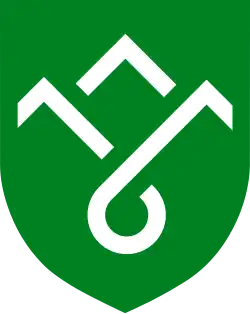Vågå Municipality
Vågå Municipality
Vågå kommune | |
|---|---|
| Vaagaa herred (historic name) Vaage herred (historic name) | |
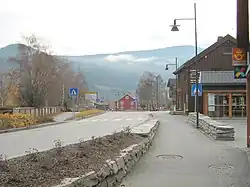 | |
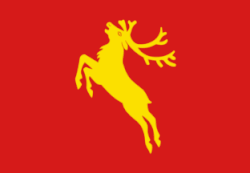 Flag 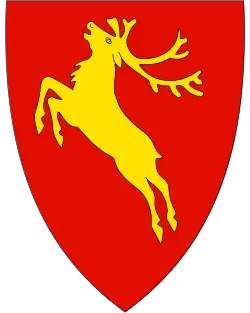 Coat of arms | |
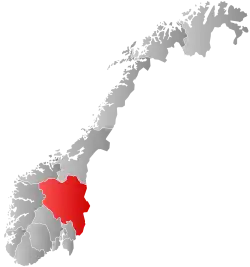 Innlandet within Norway | |
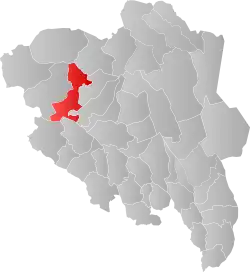 Vågå within Innlandet | |
| Coordinates: 61°50′55″N 9°7′16″E / 61.84861°N 9.12111°E | |
| Country | Norway |
| County | Innlandet |
| District | Gudbrandsdal |
| Established | 1 Jan 1838 |
| • Created as | Formannskapsdistrikt |
| Administrative centre | Vågåmo |
| Government | |
| • Mayor (2019) | Harald Sve Bjørndal (BL) |
| Area | |
• Total | 1,329.99 km2 (513.51 sq mi) |
| • Land | 1,251.95 km2 (483.38 sq mi) |
| • Water | 78.04 km2 (30.13 sq mi) 5.9% |
| • Rank | #73 in Norway |
| Highest elevation | 2,367.64 m (7,767.85 ft) |
| Population (2025) | |
• Total | 3,529 |
| • Rank | #217 in Norway |
| • Density | 2.7/km2 (7/sq mi) |
| • Change (10 years) | |
| Demonym | Vagvær[2] |
| Official language | |
| • Norwegian form | Nynorsk |
| Time zone | UTC+01:00 (CET) |
| • Summer (DST) | UTC+02:00 (CEST) |
| ISO 3166 code | NO-3435[4] |
| Website | Official website |
Vågå (Norwegian pronunciation: [ˈvôːɡoː]) is a municipality in Innlandet county, Norway. It is located in the traditional district of Gudbrandsdal. The administrative centre of the municipality is the village of Vågåmo. Other village areas in the municipality include Bessheim, Besstrond, Lalm, Maurvangen, and Tessand.
The 1,330-square-kilometre (510 sq mi) municipality is the 73rd largest by area out of the 357 municipalities in Norway. Vågå Municipality is the 217th most populous municipality in Norway with a population of 3,529. The municipality's population density is 2.7 inhabitants per square kilometre (7.0/sq mi) and its population has decreased by 4.2% over the previous 10-year period.[5][6]
General information
The prestegjeld of Vaage was established as a municipality on 1 January 1838 (see formannskapsdistrikt law). On 1 January 1908, the municipality was divided into three parts:[7]
- the northeastern part (population: 2,287) became Sel Municipality
- the southeastern part (population: 1,241) became Hedalen Municipality
- the remaining areas in the west (population: 2,953) remained as Vaage municipality
During the 1960s, there were many municipal changes across Norway due to the work of the Schei Committee. On 1 January 1965, the Tolstadåsen area of Vågå Municipality (population: 35) was transferred to the neighboring Sel Municipality.[7]
Name
The municipality (originally the parish) is named Vågå, using a very old name for the area (Old Norse: Vaga or Vága) since the first Vågå Church was built there. Two origins have been suggested for the name Vågå (historic spelling: Vaage):
- The name Vågå may come from the Old Norse word vega meaning "travel". The area lies on an ancient east–west route mentioned in the Heimskringla.
- The Old Norse form of the name may come from vaga (accusative and dative cases) from the word vagi (nominative case). It was probably originally the name of the lake Vågåvatn, but the meaning is unknown. (Maybe derived from vage which means "sleigh runner" since the shape of the lake has some similarity of form with a sleigh runner.)[8]
Historically, the name of the municipality was spelled Vaage. On 3 November 1917, a royal resolution changed the spelling of the name of the municipality to Vaagaa.[9] On 21 December 1917, a royal resolution enacted the 1917 Norwegian language reforms. Prior to this change, the name was spelled Vaagaa with the digraph "aa", and after this reform, the name was spelled Vågå, using the letter å instead. The letter å has a long vowel similar to "oh" or "aw", like in the American pronunciation of "cold" or "oar."[10][11]
Coat of arms
The coat of arms was granted on 23 August 1985. The official blazon is "Gules, a reindeer springing Or" (Norwegian: På raud grunn eit springande gull reinsdyr på skrå oppover). This means the arms have a red field (background) and the charge is a springing reindeer. The reindeer has a tincture of Or which means it is commonly colored yellow, but if it is made out of metal, then gold is used. The design symbolizes the importance of reindeer herding and hunting. It is also based on a character in Henrik Ibsen's book Peer Gynt, who rides on a reindeer bull over the Besseggen mountains. Ibsen got the idea for this book from a local story. The arms were designed by Hans H. Holm and redrawn by Ola T. Rybakken. The municipal flag has the same design as the coat of arms.[12][13][14]
Churches
The Church of Norway has one parish (sokn) within Vågå Municipality. It is part of the Nord-Gudbrandsdal prosti (deanery) in the Diocese of Hamar.
| Parish (sokn) | Church name | Location of the church | Year built |
|---|---|---|---|
| Vågå | Vågå Church | Vågåmo | 1627 |
Geography
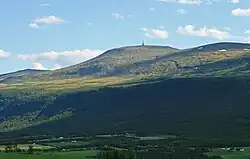

Vågå Municipality is bordered on the north by Lesja Municipality, in the east by Dovre Municipality and Sel Municipality, in the southeast by Nord-Fron Municipality, in the south by Vang Municipality and Øystre Slidre Municipality, and in the west by Lom Municipality.
Vågå Municipality lies in a mountainous region just to the east of Norway's Jotunheimen National Park, west of Rondane National Park, and south of the Dovrefjell mountains. The highest point in the municipality is the 2,367.64-metre (7,767.8 ft) tall mountain Surtningssue, located on the border with Lom Municipality.[1] Vågå Municipality includes a mountain road to the top of the1,618-metre (5,308 ft) tall Jetta mountain which provides an unobstructed view of both the Gudbrandsdalen valley and the surrounding national parks.[15]
The river Otta begins in Skjåk Municipality and flows into Vågåvatn lake. Exiting the lake Vågåvatn at Vågåmo, the river continues its journey through the Ottadalen valley leaving Vågå Municipality to meet the Gudbrandsdalslågen river at the town of Otta in Sel Municipality. Lakes in the region include Flatningen.
Climate
Vågå lies in the rain shadow from the Jotunheimen mountains which separate Eastern and Western Norway. The climate is hence characterized by a continental climate. Warm summers and cold winters dominate, and the precipitation is very low. In fact, during some years it receives less than 300 millimetres (12 in) of precipitation.[16]
This dry continental climate makes Vågå Municipality an obvious place for the national hang glider and para glider centre of Norway.
Physical geography
Although being affected by the ice-sheet history spanning the Quaternary period of the last 2.5 million years, much of the landscape are moderately imprinted by ice-sheet erosion except from in the main valleys. Even these valleys including Sjodalen and Ottadalen are of pre-Quaternary origin, and were originally sculptured by fluvial rather than glacial erosion. The numerous lakes does remind us of the glacial history, although being much more limited than in the more dramatic [fiord]s of western Norway.[17]
This limited glacial erosion also means that Vågå Municipality had limited glacial erosion during the last glacial period. Many findings of Mammoth pre-dating the last glacial maximum (LGM) have been found, being evidence of the conservative nature of the LGM in the region.
History
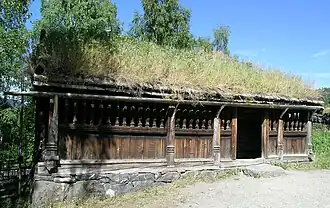
| Ancestry | Number |
|---|---|
| 34 | |
| 27 | |
| 20 | |
| 14 | |
| 12 |
The area of today's Vågå Municipality is mentioned in the Heimskringla (English: The Chronicle of the Kings of Norway) by Snorri Sturluson. The old Norse saga (Conversion of Dale-Gudbrand) relates that after King Olaf stayed several nights in Lesja, he proceeded south across the uplands to the Ottadal, and the beautiful hamlet lying there on both sides of the Otta river. King Olaf remained there five days, summoning the residents of Vågå, Lom, and Heidal to a meeting (ting). They were advised they must either receive Christianity and give their sons as hostages, or see their habitations burnt. Many submitted to his demands.[19]
Vågå Stave Church is the second oldest stave church in the country, which was constructed around 1150 and originally dedicated to St. Peter. It was converted to a cruciform church in 1625; the carved portal and wall planks are original. The baptismal font dates from the original church and a Gothic crucifix from the 13th century can be seen there as well.[20]
In 1130, Ivar Gjesling was the earliest-known owner of Sandbu (just north of Vågåmo) in Vågå. He was also King Magnus IV's lendmann for the Opplands. Sigrid Undset's fictional Lady Ragnfrid, wife of Lavrans, was created a Gjesling from Sandbu. Ivar Gjesling, allied himself with the Birchlegs (Birkebeinerne) — who chose Sverre as their king at Øreting in 1177. Sverre granted him the valley of Heidal as a reward.[19]
Farmers from Vågå participated in the successful attack on Scottish mercenary troops journeying to join Swedish forces in 1612. The legends of the Battle of Kringen lives on to this day, including the story of how the peasant girl Prillar-Guri lured the Scots into an ambush by playing of the traditional ram's horn.[19]
Ole Paulssøn Haagenstad (1775–1866) was in 1814 summoned by Christian-Frederick to plan the defense of Gudbrandsdalen in the event of a Swedish attack.[19]
Over 150 houses in the municipality are designated as historic landmarks.
Government
Vågå Municipality is responsible for primary education (through 10th grade), outpatient health services, senior citizen services, welfare and other social services, zoning, economic development, and municipal roads and utilities. The municipality is governed by a municipal council of directly elected representatives. The mayor is indirectly elected by a vote of the municipal council.[21] The municipality is under the jurisdiction of the Gudbrandsdal District Court and the Eidsivating Court of Appeal.
Municipal council
The municipal council (Kommunestyre) of Vågå Municipality is made up of 17 representatives that are elected to four year terms. The tables below show the current and historical composition of the council by political party.
| Party name (in Nynorsk) | Number of representatives | |
|---|---|---|
| Labour Party (Arbeidarpartiet) | 5 | |
| Centre Party (Senterpartiet) | 3 | |
| Socialist Left Party (Sosialistisk Venstreparti) | 2 | |
| Local list in Vågå (Bygdalista i Vågå) | 7 | |
| Total number of members: | 17 | |
| Party name (in Nynorsk) | Number of representatives | |
|---|---|---|
| Labour Party (Arbeidarpartiet) | 5 | |
| Centre Party (Senterpartiet) | 6 | |
| Socialist Left Party (Sosialistisk Venstreparti) | 2 | |
| Local list in Vågå (Bygdalista i Vågå) | 4 | |
| Total number of members: | 17 | |
| Party name (in Nynorsk) | Number of representatives | |
|---|---|---|
| Labour Party (Arbeidarpartiet) | 7 | |
| Centre Party (Senterpartiet) | 6 | |
| Socialist Left Party (Sosialistisk Venstreparti) | 1 | |
| Local list in Vågå (Bygdalista i Vågå) | 3 | |
| Total number of members: | 17 | |
| Party name (in Nynorsk) | Number of representatives | |
|---|---|---|
| Labour Party (Arbeidarpartiet) | 13 | |
| Centre Party (Senterpartiet) | 3 | |
| Socialist Left Party (Sosialistisk Venstreparti) | 1 | |
| Local list for cross-party cooperation (Bygdalista for tverrpolitisk samarbeid) | 4 | |
| Total number of members: | 21 | |
| Party name (in Nynorsk) | Number of representatives | |
|---|---|---|
| Labour Party (Arbeidarpartiet) | 15 | |
| Centre Party (Senterpartiet) | 3 | |
| Socialist Left Party (Sosialistisk Venstreparti) | 1 | |
| Local list for cross-party cooperation (Bygdalista for tverrpolitisk samarbeid) | 2 | |
| Total number of members: | 21 | |
| Party name (in Nynorsk) | Number of representatives | |
|---|---|---|
| Labour Party (Arbeidarpartiet) | 14 | |
| Centre Party (Senterpartiet) | 3 | |
| Socialist Left Party (Sosialistisk Venstreparti) | 1 | |
| Local list for cross-party cooperation (Bygdalista for tverrpolitisk samarbeid) | 3 | |
| Total number of members: | 21 | |
| Party name (in Nynorsk) | Number of representatives | |
|---|---|---|
| Labour Party (Arbeidarpartiet) | 11 | |
| Centre Party (Senterpartiet) | 6 | |
| Socialist Left Party (Sosialistisk Venstreparti) | 1 | |
| Local list for cross-party cooperation (Bygdalista for tverrpolitisk samarbeid) | 3 | |
| Total number of members: | 21 | |
| Party name (in Nynorsk) | Number of representatives | |
|---|---|---|
| Labour Party (Arbeidarpartiet) | 9 | |
| Centre Party (Senterpartiet) | 4 | |
| Socialist Left Party (Sosialistisk Venstreparti) | 2 | |
| Local list for cross-party cooperation (Bygdalista for tverrpolitisk samarbeid) | 6 | |
| Total number of members: | 21 | |
| Party name (in Nynorsk) | Number of representatives | |
|---|---|---|
| Labour Party (Arbeidarpartiet) | 7 | |
| Centre Party (Senterpartiet) | 4 | |
| Socialist Left Party (Sosialistisk Venstreparti) | 3 | |
| Local list for cross-party cooperation (Bygdalista for tverrpolitisk samarbeid) | 7 | |
| Total number of members: | 21 | |
| Party name (in Nynorsk) | Number of representatives | |
|---|---|---|
| Labour Party (Arbeidarpartiet) | 13 | |
| Conservative Party (Høgre) | 1 | |
| Centre Party (Senterpartiet) | 4 | |
| Socialist Left Party (Sosialistisk Venstreparti) | 1 | |
| Local list for cross-party cooperation (Bygdalista for tverrpolitisk samarbeid) | 2 | |
| Total number of members: | 21 | |
| Party name (in Nynorsk) | Number of representatives | |
|---|---|---|
| Labour Party (Arbeidarpartiet) | 12 | |
| Conservative Party (Høgre) | 2 | |
| Centre Party (Senterpartiet) | 4 | |
| Socialist Left Party (Sosialistisk Venstreparti) | 1 | |
| Local list for cross-party cooperation (Bygdalista for tverrpolitisk samarbeid) | 2 | |
| Total number of members: | 21 | |
| Party name (in Nynorsk) | Number of representatives | |
|---|---|---|
| Labour Party (Arbeidarpartiet) | 12 | |
| Conservative Party (Høgre) | 1 | |
| Centre Party (Senterpartiet) | 5 | |
| Socialist Left Party (Sosialistisk Venstreparti) | 1 | |
| Local list for cross-party cooperation (Bygdalista for tverrpolitisk samarbeid) | 2 | |
| Total number of members: | 21 | |
| Party name (in Nynorsk) | Number of representatives | |
|---|---|---|
| Labour Party (Arbeidarpartiet) | 13 | |
| Centre Party (Senterpartiet) | 6 | |
| Socialist Left Party (Sosialistisk Venstreparti) | 1 | |
| Joint list of the Conservative Party and Free Voters (Høyre og Frie Veljarar) |
1 | |
| Total number of members: | 21 | |
| Party name (in Nynorsk) | Number of representatives | |
|---|---|---|
| Labour Party (Arbeidarpartiet) | 13 | |
| Conservative Party (Høgre) | 1 | |
| Centre Party (Senterpartiet) | 6 | |
| Socialist People's Party (Sosialistisk Folkeparti) | 1 | |
| Total number of members: | 21 | |
| Party name (in Nynorsk) | Number of representatives | |
|---|---|---|
| Labour Party (Arbeidarpartiet) | 14 | |
| Conservative Party (Høgre) | 1 | |
| Centre Party (Senterpartiet) | 6 | |
| Total number of members: | 21 | |
| Party name (in Nynorsk) | Number of representatives | |
|---|---|---|
| Labour Party (Arbeidarpartiet) | 12 | |
| Centre Party (Senterpartiet) | 6 | |
| List of workers, fishermen, and small farmholders (Arbeidarar, fiskarar, småbrukarar liste) | 3 | |
| Total number of members: | 21 | |
| Party name (in Nynorsk) | Number of representatives | |
|---|---|---|
| Labour Party (Arbeidarpartiet) | 10 | |
| Centre Party (Senterpartiet) | 6 | |
| Liberal Party (Venstre) | 1 | |
| List of workers, fishermen, and small farmholders (Arbeidarar, fiskarar, småbrukarar liste) | 4 | |
| Total number of members: | 21 | |
| Party name (in Nynorsk) | Number of representatives | |
|---|---|---|
| Labour Party (Arbeidarpartiet) | 14 | |
| Farmers' Party (Bondepartiet) | 7 | |
| Total number of members: | 21 | |
| Party name (in Nynorsk) | Number of representatives | |
|---|---|---|
| Labour Party (Arbeidarpartiet) | 12 | |
| Farmers' Party (Bondepartiet) | 6 | |
| Liberal Party (Venstre) | 1 | |
| Local List(s) (Lokale lister) | 1 | |
| Total number of members: | 20 | |
| Party name (in Nynorsk) | Number of representatives | |
|---|---|---|
| Labour Party (Arbeidarpartiet) | 12 | |
| Christian Democratic Party (Kristeleg Folkeparti) | 1 | |
| Farmers' Party (Bondepartiet) | 6 | |
| Joint list of the Liberal Party (Venstre) and the Radical People's Party (Radikale Folkepartiet) | 1 | |
| Total number of members: | 20 | |
| Party name (in Nynorsk) | Number of representatives | |
|---|---|---|
| Labour Party (Arbeidarpartiet) | 13 | |
| Farmers' Party (Bondepartiet) | 5 | |
| Joint list of the Liberal Party (Venstre) and the Radical People's Party (Radikale Folkepartiet) | 2 | |
| Total number of members: | 20 | |
| Party name (in Nynorsk) | Number of representatives | |
|---|---|---|
| Labour Party (Arbeidarpartiet) | 11 | |
| Farmers' Party (Bondepartiet) | 5 | |
| Local List(s) (Lokale lister) | 4 | |
| Total number of members: | 20 | |
| Note: Due to the German occupation of Norway during World War II, no elections were held for new municipal councils until after the war ended in 1945. | ||
Mayors
The mayor (Nynorsk: ordførar) of Vågå Municipality is the political leader of the municipality and the chairperson of the municipal council. Since 1946, all mayors with three exceptions have represented the Norwegian Labour Party. Here is a list of people who have held this position:[42]
- 1838–1865: Andreas Molbech Lundh
- 1866–1867: Ole Syversen Wæggum
- 1868–1869: John Syversen Blessum
- 1870–1872: Iver Olsen Lunde[43]
- 1872–1875: John Syversen Blessum[44]
- 1876–1879: Ole Lunde Sørem[45]
- 1880–1881: John Syversen Blessum[46]
- 1882–1883: Iver Johannessen Sandnes[47]
- 1884–1887: Christian Antonsen Horne[48]
- 1888–1889: Jens Christian Krohg[49]
- 1890–1901: Hans Andersen Raastad (V)[50]
- 1902–1904: John Olsen Nordahl (LL)[51]
- 1905–1907: Ole Iversen Moen (LL)[52]
- 1908–1908: Syver Erichson (LL)[53]
- 1908–1910: Ole Iversen Moen (LL)[54]
- 1911–1916: Kristoffer Hansen Hole (V)[55]
- 1917–1931: Johan Knudsen Øverstedal (ArbDem)[56]
- 1932–1932: Hans Olsen Hjelvik (Ap)
- 1932–1934: Ole Olsen Sveen (Ap)
- 1935–1941: Syver Larsen Kleiven (Ap)
- 1941–1944: Iver Valde (NS)
- 1944–1945: Sigurd Stokstad (NS)
- 1945–1945: Syver Larsen Kleiven (Ap)
- 1946–1951: Ole Martinus Høgåsen (Ap)
- 1952–1959: Anders Persen Bjørkheim (Ap)
- 1960–1961: Ola Olsen Kleiven (LL)
- 1961–1963: Kaspar Johansen Øvstedal (Ap)
- 1963–1983: Sigurd Kristoffersen Granrud (Ap)
- 1983–1987: Sverre Damstuen (Ap)
- 1987–1991: Kjell Olsen Nyhus (Ap)
- 1991–1995: Kari Hølmo Holen (Sp)
- 1995–2011: Rune Øygard (Ap)
- 2011–2019: Iselin Jonassen (Ap)
- 2019–present: Harald Sve Bjørndal (BL)
Politics
Øygard case
In the September 2011 election, Rune Øygard was reelected as mayor, after having served in that role since 1995. His reelection by the municipal council was controversial as he was already under police investigation for alleged child sexual abuse,[57] the so-called Øygard case, sometimes also referred to as the Vågå case. Øygard was granted temporary leave following his indictment in the case, and was succeeded as acting mayor by Iselin Jonassen (Labour) on 8 May 2012. After being found guilty and sentenced to four years imprisonment, Rune Øygard resigned as mayor. His resignation was granted by the municipal council on 18 December 2012, effective immediately.[58]
Notable people
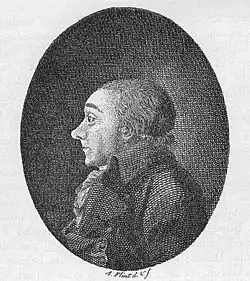

- Edvard Storm (1749 in Vågå - 1794), a poet, songwriter, and educator
- Johan Storm Munch (1778 at Vågå – 1832), a Bishop in the Church of Norway, poet, playwright, and magazine editor
- Jo Gjende (1794 in Vågå – 1884), an outdoorsman and freethinker who may have been the model for Henrik Ibsen’s Peer Gynt
- Ole Herman Johannes Krag (1837 in Vågå – 1916), a Norwegian officer and firearms designer
- Ivar Kleiven (1854 in Vågå - 1934), a politician, historian, poet, and collector of local folklore
- Kristian Prestgard (1866 in Heidal -1946), an American journalist, author, and editor of Decorah-Posten
- Kristen Holbø (1869 in Vågå – 1953), a painter of landscapes and illustrator
- Thekla Resvoll (1871 in Vågå – 1948), a botanist and educator
- Benjamin Blessum (1877-1954), a Norwegian-American painter and illustrator whose parents were from Vågå
- Ragnvald Skrede (1904 in Vågå - 1983), an author, journalist, literature critic, and poet
- Ivar P. Enge (1922 in Vågå – 2013), a radiologist who specialized in interventional radiology
- Arne Brimi (born 1957), a chef and food writer that lives and works in Vågå
Sister cities
Vågå has sister city agreements with the following places:[59]
References
- ^ a b "Høgaste fjelltopp i kvar kommune" (in Norwegian). Kartverket. 16 January 2024.
- ^ "Navn på steder og personer: Innbyggjarnamn" (in Norwegian). Språkrådet.
- ^ "Forskrift om målvedtak i kommunar og fylkeskommunar" (in Norwegian). Lovdata.no.
- ^ Bolstad, Erik; Thorsnæs, Geir, eds. (9 January 2024). "Kommunenummer". Store norske leksikon (in Norwegian). Foreningen Store norske leksikon.
- ^ Statistisk sentralbyrå (2022). "Table: 06913: Population 1 January and population changes during the calendar year (M)" (in Norwegian).
- ^ Statistisk sentralbyrå (2022). "09280: Area of land and fresh water (km²) (M)" (in Norwegian).
- ^ a b Jukvam, Dag (1999). "Historisk oversikt over endringer i kommune- og fylkesinndelingen" (PDF) (in Norwegian). Statistisk sentralbyrå. ISBN 9788253746845.
- ^ Rygh, Oluf (1900). Norske gaardnavne: Kristians amt (in Norwegian) (4 ed.). Kristiania, Norge: W. C. Fabritius & sønners bogtrikkeri. pp. 68–69.
- ^ "Norsk Lovtidende. 2den Afdeling. 1917. Samling af Love, Resolutioner m.m". Norsk Lovtidend (in Norwegian). Kristiania, Norge: Grøndahl og Søns Boktrykkeri: 1057–1065. 1917.
- ^ "Norsk Lovtidende. 2den Afdeling. 1917. Samling af Love, Resolutioner m.m". Norsk Lovtidend (in Norwegian). Oslo, Norway: Grøndahl og Søns Boktrykkeri: 1000. 1917.
- ^ Den Nye rettskrivning : regler og ordlister (in Norwegian). Kristiania, Norge: Den Mallingske Boktrykkeri. 1918.
- ^ "Civic heraldry of Norway - Norske Kommunevåpen". Heraldry of the World. Retrieved 17 April 2023.
- ^ "Vågå, Oppland (Norway)". Flags of the World. Retrieved 17 April 2023.
- ^ "Godkjenning av våpen og flagg". Lovdata.no (in Norwegian). Norges kommunal- og arbeidsdepartementet. 30 August 1985. Retrieved 17 April 2023.
- ^ Welle-Strand, Erling (1996). Adventure Roads in Norway. Nortrabooks. ISBN 9788290103717.
- ^ Lemmer, Gerhard; Frey, Elke; Rahe, Helge (2001). Norway (2 ed.). Nelles Verlag GmbH. ISBN 3886188973.
- ^ Cornwallis, Graeme; Bender, Andrew; Swaney, Deana (2002). Loney Planet Norway (2 ed.). Lonely Planet Publications. ISBN 9781740592000.
- ^ "Immigrants and Norwegian-born to immigrant parents, by immigration category, country background and percentages of the population". ssb.no. Archived from the original on 2 July 2015. Retrieved 29 June 2015.
- ^ a b c d Stagg, Frank Noel (1956). East Norway and its Frontier. George Allen and Unvin, Ltd.
- ^ Taylor-Wilkie, Doreen, ed. (1996). Insight Guides Norway (2 ed.). Houghton Mifflin Company. ISBN 978-0-395-81912-8.
- ^ Hansen, Tore; Vabo, Signy Irene, eds. (25 November 2024). "kommunestyre". Store norske leksikon (in Norwegian). Foreningen Store norske leksikon. Retrieved 31 December 2024.
- ^ "Kommunestyrevalg 2023 - Innlandet". Valgdirektoratet. Retrieved 13 January 2024.
- ^ "Kommunestyrevalg 2019 - Innlandet". Valgdirektoratet. Retrieved 13 April 2022.
- ^ "Kommunestyrevalg 2015 - Oppland". Valgdirektoratet.
- ^ a b c d "Table: 04813: Members of the local councils, by party/electoral list at the Municipal Council election (M)" (in Norwegian). Statistics Norway.
- ^ "Kommunestyrevalg 2011 - Oppland". Valgdirektoratet.
- ^ "Kommunestyrevalget 1995" (PDF) (in Norwegian). Oslo-Kongsvinger: Statistisk sentralbyrå. 1996. Retrieved 12 December 2020.
- ^ "Kommunestyrevalget 1991" (PDF) (in Norwegian). Oslo-Kongsvinger: Statistisk sentralbyrå. 1993. Retrieved 12 December 2020.
- ^ "Kommunestyrevalget 1987" (PDF) (in Norwegian). Oslo-Kongsvinger: Statistisk sentralbyrå. 1988. Retrieved 12 December 2020.
- ^ "Kommunestyrevalget 1983" (PDF) (in Norwegian). Oslo-Kongsvinger: Statistisk sentralbyrå. 1984. Retrieved 12 December 2020.
- ^ "Kommunestyrevalget 1979" (PDF) (in Norwegian). Oslo: Statistisk sentralbyrå. 1979. Retrieved 12 December 2020.
- ^ "Kommunevalgene 1975" (PDF) (in Norwegian). Oslo: Statistisk sentralbyrå. 1977. Retrieved 12 December 2020.
- ^ "Kommunevalgene 1972" (PDF) (in Norwegian). Oslo: Statistisk sentralbyrå. 1973. Retrieved 12 December 2020.
- ^ "Kommunevalgene 1967" (PDF) (in Norwegian). Oslo: Statistisk sentralbyrå. 1967. Retrieved 12 December 2020.
- ^ "Kommunevalgene 1963" (PDF) (in Norwegian). Oslo: Statistisk sentralbyrå. 1964. Retrieved 12 December 2020.
- ^ "Kommunevalgene og Ordførervalgene 1959" (PDF) (in Norwegian). Oslo: Statistisk sentralbyrå. 1960. Retrieved 12 December 2020.
- ^ "Kommunevalgene og Ordførervalgene 1955" (PDF) (in Norwegian). Oslo: Statistisk sentralbyrå. 1957. Retrieved 12 December 2020.
- ^ "Kommunevalgene og Ordførervalgene 1951" (PDF) (in Norwegian). Oslo: Statistisk sentralbyrå. 1952. Retrieved 12 December 2020.
- ^ "Kommunevalgene og Ordførervalgene 1947" (PDF) (in Norwegian). Oslo: Statistisk sentralbyrå. 1948. Retrieved 12 December 2020.
- ^ "Kommunevalgene og Ordførervalgene 1945" (PDF) (in Norwegian). Oslo: Statistisk sentralbyrå. 1947. Retrieved 12 December 2020.
- ^ "Kommunevalgene og Ordførervalgene 1937" (PDF) (in Norwegian). Oslo: Statistisk sentralbyrå. 1938. Retrieved 12 December 2020.
- ^ Ottosen, Gunnar (2013). "Ordførere i Vågå" (PDF). Jutulen. Vågå Historielag: 70–80.
- ^ "Lillehammer, 19 Juni". Kristians Amtstidende (in Norwegian). 23 June 1871. p. 3. Retrieved 14 August 2025.
- ^ "Amtsformandskabet for Kristians amt". Kristians Amtstidende (in Norwegian). 21 June 1872. p. 3. Retrieved 14 August 2025.
- ^ "Kristians Amtsformandskab". Kristians Amtstidende (in Norwegian). 23 June 1876. p. 1. Retrieved 14 August 2025.
- ^ "Kristians Amtsformandskab". Lillehammer Tilskuer (in Norwegian). 23 June 1880. p. 2. Retrieved 14 August 2025.
- ^ "Amtsformandskabet for Kristians Amt". Lillehammer Tilskuer (in Norwegian). 21 June 1882. p. 2. Retrieved 14 August 2025.
- ^ "Kristians Amtsformandskab". Gjøviks Blad (in Norwegian). 27 June 1884. p. 3. Retrieved 14 August 2025.
- ^ "Amtsformandskabet for Kristians Amt". Framgang (in Norwegian). 16 June 1888. p. 3. Retrieved 14 August 2025.
- ^ "Amtsformandskabet for Kristians Amt". Framgang (in Norwegian). 21 June 1890. p. 2. Retrieved 14 August 2025.
- ^ "Amtstinget". Lillehammer Tilskuer (in Norwegian). 18 March 1902. p. 1. Retrieved 14 August 2025.
- ^ "Kristians Amtsting". Gudbrandsdølen (in Norwegian). 14 March 1905. p. 2. Retrieved 14 August 2025.
- ^ "I Kristians Amt". Gudbrandsdølen (in Norwegian). 14 January 1908. p. 1. Retrieved 14 August 2025.
- ^ "Kristians Amtsting". Vestoplændingen (in Norwegian). 12 March 1910. p. 2. Retrieved 14 August 2025.
- ^ "Ordførervalgene i Kristians amt". Gudbrandsdalens Folkeblad (in Norwegian). 5 January 1911. p. 2. Retrieved 14 August 2025.
- ^ "Kristians Amtsting". Samhold (in Norwegian). [[Gjøvik (town)|]]. 21 March 1917. p. 2. Retrieved 14 August 2025.
- ^ "Overgrepssiktede Rune Øygard (Ap) gjenvalgt som ordfører".
- ^ "Rune Øygard trekker seg som ordfører".
- ^ "Vennskapskommuner" (in Norwegian). Vågå kommune. Archived from the original on 24 July 2011. Retrieved 3 January 2009.
External links
- Municipal fact sheet from Statistics Norway (in Norwegian)
- Map of Vågå municipality in Kulturnett.no (in Norwegian)
- Vågå Wavecamp
